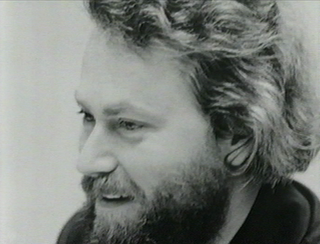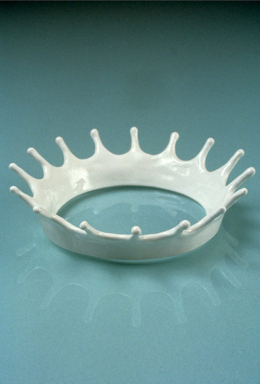
Bruce Nauman is an American artist. His practice spans a broad range of media including sculpture, photography, neon, video, drawing, printmaking, and performance. Nauman lives near Galisteo, New Mexico.

Donald Clarence Judd was an American artist associated with minimalism. In his work, Judd sought autonomy and clarity for the constructed object and the space created by it, ultimately achieving a rigorously democratic presentation without compositional hierarchy. He is generally considered the leading international exponent of "minimalism", and its most important theoretician through such writings as "Specific Objects" (1964). Judd voiced his unorthodox perception of minimalism in Arts Yearbook 8, where he says, "The new three dimensional work doesn't constitute a movement, school, or style. The common aspects are too general and too little common to define a movement. The differences are greater than the similarities."

Solomon "Sol" LeWitt was an American artist linked to various movements, including conceptual art and minimalism.

Anne Truitt, born Anne Dean, was an American sculptor of the mid-20th century.

Thomas Hirschhorn is a Swiss artist who lives and works in Paris.

Shigeko Kubota was a Japanese video artist, sculptor and avant-garde performance artist, who mostly lived in New York City. She was one of the first artists to adopt the portable video camera Sony Portapak in 1970, likening it to a "new paintbrush." Kubota is known for constructing sculptural installations with a strong DIY aesthetic, which include sculptures with embedded monitors playing her original videos. She was a key member and influence on Fluxus, the international group of avant-garde artists centered on George Maciunas, having been involved with the group since witnessing John Cage perform in Tokyo in 1962 and subsequently moving to New York in 1964. She was closely associated with George Brecht, Jackson Mac Low, John Cage, Joe Jones, Nam June Paik, and Ay-O, among other members of Fluxus. Kubota was deemed "Vice Chairman" of the Fluxus Organization by Maciunas.

Isa Genzken is a German artist who lives and works in Berlin. Her primary media are sculpture and installation, using a wide variety of materials, including concrete, plaster, wood and textile. She also works with photography, video, film and collage.
Eileen MacDonagh was born in Geevagh, County Sligo in 1956 and has worked as a sculptor since the 1980s. For her contribution to sculpture and the Arts in Ireland, MacDonagh was elected in 2004 to Aosdána, the Irish organisation that recognises artists that have contributed a unique body of work.
Agnes Denes is a Hungarian-born American conceptual artist based in New York. She is known for works in a wide range of media—from poetry and philosophical writings to extremely detailed drawings, sculptures, and iconic land art works, such as Wheatfield — A Confrontation (1982), a two-acre field of wheat in downtown Manhattan, commissioned by the Public Art Fund, and Tree Mountain—A Living Time Capsule (1992–96) in Ylöjärvi, Finland. Her work Rice/Tree/Burial with Time Capsule (1968–79) is recognized as one of the earliest examples of ecological art. She lives and works in New York City.
Michelle Stuart is an American multidisciplinary artist known for her sculpture, painting and environmental art. She is based in New York City.

Tania was a Polish-born Jewish American abstract painter, sculptor, collage artist and painter of city walls.
Vera Jacqueline Winsor is a Canadian-born American sculptor. Her style, which developed in the early 1970s as a reaction to the work of minimal artists, has been characterized as post-minimal, anti-form, and process art.
Lila Katzen, born Lila Pell, was an American sculptor of fluid, large-scale metal abstractions.

Mary Miss is an American artist and designer. Her work has crossed boundaries between architecture, landscape architecture, engineering and urban design. Her installations are collaborative in nature: she has worked with scientists, historians, designers, and public administrators. She is primarily interested in how to engage the public in decoding their surrounding environment.

Jennifer Bolande is an American postconceptual artist. Her art explores affinities and shifts of meaning among sets of objects and images across different contexts and media including sculpture, photography, film and installation. She emerged in the early 1980s with work that expanded on ideas and strategies rooted in conceptualism, Pop, Arte Povera and the so-called Pictures Generation. Her work focuses on thresholds, liminal and peripheral spaces, and transitional moments—states she enacts by the repetition, accumulation and recontextualization of found materials. She frequently selects cultural artifacts on the verge of obsolescence or in flux—and thus acquiring new meanings—and archives, studies and reframes them. Artforum critic Paula Marincola wrote, "Bolande's highly individualized amalgam of sculpture and photography proceeds obliquely but precisely toward an accumulation of possible meanings. She is a connoisseur of unlikely but evocative details, of subliminally perceived, fragmentary images and events."
Donna Dennis is an American sculptor, painter, and printmaker. She is one of a small group of groundbreaking women, including Alice Aycock, Jackie Ferrara and Mary Miss, who pushed sculpture toward the domain of architecture in the early 1970s. “When Donna Dennis created her earnest, plain-spoken Tourist Cabins at the outset of her career,” writes Deborah Everett in Sculpture Magazine, “they had the impact of cultural icons.” Drawing from overlooked fragments of rural and urban vernacular American architecture—tourist cabins, hotels, subway stations, roller coasters—Dennis represents stopping places on the journey through life.

Coleen Sterritt is an American sculptor known for abstracted, hybrid works made from a myriad of everyday objects and materials, combined in unexpected ways. Writers root her work in the tradition of post-minimalists Jackie Winsor, Eva Hesse and Nancy Graves, and assemblage artists such as Louise Nevelson, Robert Rauschenberg and Marisa Merz; she is sometimes associated with contemporaries Jessica Stockholder, Nancy Rubins, and Tony Cragg. Sculpture critic Kay Whitney suggests Sterritt's work "expands and reinterprets three of the most important artistic inventions of the 20th Century—collage, abstraction and the readymade"— in play with the traditions of Arte Povera bricolage and Surrealist psychological displacement. Curator Andi Campognone considers Sterritt one of the most influential post-1970s artists in establishing "the Los Angeles aesthetic" in contemporary sculpture, while others identify her as an inspiration for later West Coast artists creating hand-made, free-standing sculpture counter to trends toward interventions, public art and environmental works. Constance Mallinson writes that Sterritt's work "walks a line between charm and threat, the natural, the industrial and the hand fabricated, rejecting easy associations for complex reads." Los Angeles Times critic David Pagel calls it smart, funky and "subtly rebellious" in its refashioning of discarded material, dumpster finds, and art-historical lineages.
Phyllis Mark was an American modern artist. She was a leading proponent of kinetic sculpture, rotating indoor works on motors, outdoor works by wind or water. Mark also had an enduring interest in light. She first generated light within the work itself, using small electric bulbs. Later she began to work in polished metal, creating interactions between the work, its reflections, and cast shadows. She was an early proponent of sculptural editions, first in small scale, her Sculpture-to-wear, art conceived as jewelry, later in her larger kinetic works. Throughout her career, Mark explored concepts in her art alongside pure abstraction. An important example in two dimensions is a form of picture writing that she termed Color Alphabet. In her sculptures, conceptual interests, always implicit, became increasing explicit over time. In late career she executed a number of large-scale works, photographed the work and its intended site, and "sited" the work in photomontage.
Frances Barth is an American visual artist best known for paintings situated between abstraction, landscape and mapping, and in her later career, video and narrative works. She emerged during a period in which contemporary painters sought a way forward beyond 1960s minimalism and conceptualism, producing work that combined modernist formalism, geometric abstraction, referential elements and metaphor. Critic Karen Wilkin wrote, "Barth's paintings play a variety of spatial languages against each other, from aerial views that suggest mapping, to suggestions of perspectival space, to relentless flatness ... [she] questions the very pictorial conventions she deploys, creating ambiguous imagery and equally ambiguous space that seems to shift as we look."

Arlene Slavin is a painter, sculptor, and a print-maker whose practice also includes large-scale public art commissions. Slavin is a 1977 National Endowment for the Arts Grant recipient.













